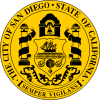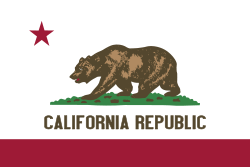San Diego
| City of San Diego | |||||||||||
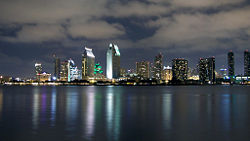 |
|||||||||||
|
|||||||||||
| Nickname(s): America's Finest City | |||||||||||
| Motto: Semper Vigilans (Latin for Ever Vigilant) | |||||||||||
 within San Diego County |
|||||||||||
| Country | United States | ||||||||||
|---|---|---|---|---|---|---|---|---|---|---|---|
| State | California | ||||||||||
| County | San Diego | ||||||||||
| Founded | July 16, 1769 | ||||||||||
| Incorporated | March 27, 1850 | ||||||||||
| Government | |||||||||||
| - Type | Mayor-council | ||||||||||
| - Mayor | Jerry Sanders (R) | ||||||||||
| - City Attorney | Michael Aguirre | ||||||||||
| - City Council | Scott Peters Kevin Faulconer Toni Atkins Tony Young Brian Maienschein Donna Frye Jim Madaffer Ben Hueso |
||||||||||
| Area | |||||||||||
| - City | 372.1 sq mi (963.6 km²) | ||||||||||
| - Land | 324.3 sq mi (840.0 km²) | ||||||||||
| - Water | 47.7 sq mi (123.5 km²) | ||||||||||
| Elevation | 72 ft (22 m) | ||||||||||
| Population (2007)[1] | |||||||||||
| - City | 1,266,731 | ||||||||||
| - Density | 3,871.5/sq mi (1,494.7/km²) | ||||||||||
| - Metro | 2,941,454 Including Tijuana: 4,922,723 |
||||||||||
| - Ranked | 8th | ||||||||||
| Time zone | PST (UTC-8) | ||||||||||
| - Summer (DST) | PDT (UTC-7) | ||||||||||
| ZIP code | 92101-92117, 92119-92124, 92126-92140, 92142, 92145, 92147, 92149-92155, 92158-92172, 92174-92177, 92179, 92182, 92184, 92186, 92187, 92190-92199 | ||||||||||
| Area code(s) | 619, 858 | ||||||||||
| FIPS code | 06-66000 | ||||||||||
| GNIS feature ID | 1661377 | ||||||||||
|
|||||||||||
| Website: http://www.sandiego.gov/ | |||||||||||
San Diego (pronounced /ˌsændiˈeɪgoʊ/) is a large coastal Southern California city located in the southwestern corner of the continental United States. In 2007, the city's population was estimated to be 1,266,731.[1] It is the second largest city in California and the eighth largest city in the United States, by population. It is the county seat of San Diego County[2] and is the economic center of the San Diego–Carlsbad–San Marcos metropolitan area, the 17th-largest in the United States with a population of 3,146,274 as of 2008, and the 21st-largest metropolitan area in the Americas when including Tijuana (See San Diego-Tijuana Metro.).
San Diego County lies just north of the Mexican border—sharing a border with Tijuana—and lies south of Orange County. It is home to miles of beaches, a mild Mediterranean climate and 16 military facilities hosting the United States Navy, the United States Coast Guard and the United States Marine Corps.
The presence of the University of California, San Diego (UCSD) with the affiliated UCSD Medical Center promotes research in biotechnology.[3] San Diego's economy is largely composed of agriculture, biotechnology/biosciences, computer sciences, electronics manufacturing, defense-related manufacturing, financial and business services, ship-repair and construction, software development, telecommunications, and tourism.
Contents |
History
The area has long been inhabited by the Kumeyaay people. The first European to visit the region was Portuguese-born explorer Juan Rodrigues Cabrillo sailing under the Spanish Flag, (1499 - 1543), who sailed his flagship San Salvador from Navidad, New Spain. Cabrillo claimed the bay for the Spanish Empire and named the site San Miguel. In November of 1602, Sebastián Vizcaíno was sent to map the California coast. Arriving on his flagship San Diego, Vizcaíno surveyed the harbor and what are now Mission Bay and Point Loma and named the area for the Catholic Saint Didacus, a Spaniard more commonly known as San Diego. On November 12, 1602, the first Christian religious service of record in Alta California was conducted by Fray Antonio de la Ascensión, a member of Vizcaíno's expedition, to celebrate the feast day of San Diego.

In 1769, Gaspar de Portolà established the Presidio of San Diego (a military post) overlooking Old Town. Around the same time, Mission San Diego de Alcalá was founded by Franciscan friars under Father Junípero Serra. By 1797, the mission boasted the largest native population in Alta California, with over 1,400 neophytes living in and around the mission proper. After New Spain won its independence from the Spanish Empire in 1823, Mission San Diego de Alcalá's fortunes declined in the 1830s after the decree of secularization was enacted, as was the case with all of the missions under the control of Mexico. In 1847 San Diego was a destination of the 2,000-mile (3,200 km) march of the Mormon Battalion which built the city's first courthouse with brick.
After the Battle of San Pasqual, the end of the Mexican-American War, and the gold rush of 1848, San Diego was designated the seat of the newly-established San Diego County and was incorporated as a city in 1850. In the years before World War I, the Industrial Workers of the World labor union conducted a free speech fight in San Diego, arousing a brutal response (see San Diego Free Speech Fight.)
Significant U.S. Naval presence began in 1907 with the establishment of the Navy Coaling Station, which gave further impetus to the development of the town. San Diego hosted two World's Fairs, the Panama-California Exposition in 1915, and the California Pacific International Exposition in 1935. Many of the Spanish/Baroque-style buildings in the city's Balboa Park were built for these expositions, particularly the one in 1915. Intended to be temporary structures, most remained in continuous use until they progressively fell into disrepair. All were eventually rebuilt using castings of the original facades to faithfully retain the architectural style.
After World War II, the military played an increasing role in the local economy, but post-Cold War cutbacks took a heavy toll on the local defense and aerospace industries. The resulting downturn led San Diego leaders to seek to diversify the city's economy, and San Diego has since become a major center of the emerging biotechnology industry. It is also home to telecommunications giant Qualcomm.


Downtown San Diego has been undergoing an urban renewal since the early 1980s, beginning with the opening of Horton Plaza, the revival of the Gaslamp Quarter, and the construction of the San Diego Convention Center. The Centre City Development Corporation (CCDC), San Diego's downtown redevelopment agency, has transformed what was a largely abandoned downtown into a glittering showcase of waterfront skyscrapers, expensive live-work loft developments, five-star hotels, and many cafes, restaurants, and boutiques.
The North Embarcadero is slated to have parks in addition to a waterfront promenade. And Balboa Park will be linked to downtown with a view corridor. The recent boom in the construction of condos and skyscrapers has brought with it a gentrification frenzy, and some people are concerned that speculators have played too big a role in the condo market downtown. In the meantime, the city is committed to a "smart growth" development scheme that would increase density along transit corridors in older neighborhoods (the "City of Villages" planning concept.) Some neighborhoods are resisting this planning approach, but "mixed-use development" has had its successes, especially the award-winning Uptown Shopping Center in Hillcrest.
The latest accomplishment of CCDC has been the recent inauguration of PETCO Park. The once-industrial East Village adjacent to the new ballpark is now the new frontier in San Diego's downtown urban renewal.
A series of scandals has rocked the city in recent years. With mounting pressure aggravated by underfunding of pensions for city employees that began prior to his administration, Mayor Dick Murphy, in April 2005, announced his intention to resign by mid-July. Two city council members, Ralph Inzunza and deputy mayor Michael Zucchet — who was to take Murphy's place — were ultimately convicted of extortion, wire fraud, and conspiracy to commit wire fraud for taking campaign contributions from a strip club owner and his associates, allegedly in exchange for trying to repeal the city's "no touch" laws at strip clubs. Both subsequently resigned. The judge later set aside (overturned) the conviction in Zucchet's case.
On November 28, 2005, U.S. Congressman Randy "Duke" Cunningham resigned over a bribery scandal. Cunningham represented California's 50th congressional district, which mostly lies outside (north) of the city of San Diego proper. He is currently serving a one-hundred-month prison sentence.
Geography
- See also: Beaches in San Diego, California and Parks in San Diego, California

The city of San Diego itself has deep canyons separating its mesas, creating small pockets of natural parkland scattered throughout the city. The same canyons give parts of the city a highly segmented feel, creating literal gaps between otherwise proximal neighborhoods and contributing to a low-density, car-centered built environment. Downtown San Diego is located on San Diego Bay. Balboa Park lies on a mesa to the northeast. It is surrounded by several dense urban communities and abruptly ends in Hillcrest to the north. The Coronado and Point Loma peninsulas separate San Diego Bay from the ocean. Ocean Beach is on the west side of Point Loma. Mission Beach and Pacific Beach lie between the ocean and Mission Bay, a man-made aquatic park. La Jolla, an affluent community, lies north of Pacific Beach. Mountains rise to the east of the city, and beyond the mountains are desert areas. Cleveland National Forest is a half-hour drive from downtown San Diego. Numerous farms are found in the valleys northeast and southeast of the city. San Diego County has one of the highest counts of animal and plant species that appear on the endangered species list among counties in the United States.[4]
Climate
San Diego has a temperate, Mediterranean (Csa) climate when classified using the Koppen climate classification system, which is characterized by hot, dry summers and cool, wet winters.[5] San Diego enjoys mild, mostly dry and plenty of sunshine throughout the year with 264 sunshine days annually.[6] Temperatures vary little throughout the year. Summer or dry period of May to October are mild to warm with average high temperatures of 70 - 78°F (21 - 26°C) and lows of 55 - 66°F (13 - 19°C), and temperatures only exceed 90°F (32°C) 4 days a year. Winter or rainy period of November to April are mild and somewhat rainy with high temperatures of 66 - 70°F (19 - 21°C) and lows of 50 - 56°F (10 - 13°C).
Climate in the San Diego area and the rest of California often varies dramatically over short geographical distances, due to the city's topography (the Bay, and the numerous hills, mountains, and canyons): frequently, particularly during the "May gray / June gloom" period, a thick "marine layer" cloud cover will keep the air cool and damp within a few miles of the coast, but will yield to bright cloudless sunshine between about 5 and 15 miles (9 - 24 km) inland—the cities of El Cajon and Santee for example, rarely experience the cloud cover. This phenomenon is known as microclimate.
Rainfall averages only about 10 inches (251 mm) of precipitation annually, which occurs mainly during the cooler months of December through April with few wet days per month during the rainy period, but it could be heavy once it rains.
| Month | Jan | Feb | Mar | Apr | May | Jun | Jul | Aug | Sep | Oct | Nov | Dec | Year |
|---|---|---|---|---|---|---|---|---|---|---|---|---|---|
| Average high °F (°C) | 66 (19) |
66 (19) |
66 (19) |
69 (21) |
69 (21) |
72 (22) |
76 (24) |
78 (26) |
77 (25) |
74 (23) |
70 (21) |
66 (19) |
71 (22) |
| Average low °F (°C) | 50 (10) |
52 (11) |
54 (12) |
56 (13) |
60 (16) |
63 (17) |
66 (19) |
67 (19) |
66 (19) |
61 (16) |
54 (12) |
49 (9) |
57 (14) |
| Precipitation inches (mm) | 2.2 (55.9) |
1.6 (40.6) |
1.9 (48.3) |
0.8 (20.3) |
0.2 (5.1) |
0.1 (2.5) |
0 (0) |
0.1 (2.5) |
0.2 (5.1) |
0.4 (10.2) |
1.1 (27.9) |
1.4 (35.6) |
9.9 (251.5) |
| Source: {{{source}}} {{{accessdate}}} | |||||||||||||
Ecology
Like most of southern California, the majority of San Diego's current area was originally occupied by chaparral, a plant community made up mostly of drought-resistant shrubs. The endangered Torrey Pine has the bulk of its population in San Diego in a stretch of protected chapparral along the coast. The steep and varied topography, and proximity to the ocean creates a number of different habitats within the city limits, including tidal marsh and canyons. The influence of humans has altered existing habitats and has also created habitats that did not exist prior to human development, by construction of buildings, the introduction of new species, and the use of water for lawns and gardens. A number of species of parrots, including the Red-masked Parakeet and Red-crowned Amazon have established feral populations in urban neighborhoods such as Ocean Beach.
San Diego's broad city limits encompass a number of large nature preserves, including Torrey Pines State Reserve, Border Field State Park, Mission Trails Regional Park. Torrey Pines State Preserve and a coastal strip continuing to the north is the only location where the rare species of Torrey Pine, P. torreyana torreyana, is found.[7] Due to a combination of the steep topography that prevents or discourages building, and some efforts for preservation, there are also a large number of canyons within the city limits that are nature preserves, including Tecolote Canyon Natural Park,[8] and Marian Bear Memorial Park in the San Clemente Canyon,[9] as well as a number of small parks and preserves.
Fire
The chaparral and coastal sage scrub habitats in low elevations along the coast are prone to wildfire, and the rates of fire have increased in the 20th century, due primarily to fires starting near the borders of urban and wild areas.[10] In 2003, San Diego was the site of what has been called the largest wildfire in California over the past century.[11] In addition to damage caused by the fire, smoke from the fire resulted in a significant increase in emergency room visits due to asthma, respiratory problems, eye irritation, and smoke inhalation.[12]
Communities and neighborhoods
There are around one hundred named areas within the city of San Diego.
| Communities of San Diego |
|---|

Old Town, San Diego.
Northern: Bay Ho, Bay Park, Carmel Valley, Clairemont Mesa East, Clairemont Mesa West, Del Mar Mesa, La Jolla, La Jolla Village, Mission Beach, Mission Bay Park, North City, North Clairemont, Pacific Beach, Pacific Highlands Ranch, Torrey Hills, Torrey Pines, University City Northeastern: Black Mountain Ranch, Carmel Mountain Ranch, Miramar, Miramar Ranch North, Mira Mesa, Rancho Bernardo, Rancho Encantada, Rancho Peñasquitos, Sabre Springs, San Pasqual Valley, Scripps Ranch, Sorrento Valley, Torrey Highlands Eastern: Allied Gardens, Birdland, Del Cerro, Grantville, Kearny Mesa, Lake Murray, Mission Valley East, San Carlos,Serra Mesa, Tierrasanta Western: Burlingame, Hillcrest, La Playa, Linda Vista, Loma Portal, Midtown, Midway District, Mission Hills, Mission Valley West, Morena, North Park, Ocean Beach, Old Town, Point Loma Heights, Roseville-Fleetridge, Sunset Cliffs, University Heights, Wooded Area Central: Balboa Park, Bankers Hill, Barrio Logan, City Heights, Downtown (Columbia, Core, Cortez Hill, East Village, Gaslamp Quarter, Horton, Little Italy, Marina), Golden Hill, Grant Hill, Logan Heights, Memorial, Middletown, Sherman Heights, South Park, Stockton Mid-City: City Heights (comprising Azalea Park, Bayridge, Hollywood Park, Castle, Cherokee Point, Chollas Creek, Colina Del Sol, Corridor, Fairmount, Fox Canyon, Islenair, Ridgeview/Webster Rolando, Swan Canyon, Teralta East, Teralta West), College East, College West, Darnall, El Cerrito, Gateway, Kensington, Normal Heights, Oak Park, Talmadge, Alvarado Estates Southeastern: Alta Vista, Bay Terrace, Broadway Heights, Chollas View, Emerald Hills, Encanto, Jamacha-Lomita, Lincoln Park, Mountain View, Mt. Hope, Paradise Hills, Shelltown, Skyline, Southcrest, Valencia Park Southern: Egger Highlands, Imperial Beach, Nestor, Ocean Crest, Otay Mesa, Otay Mesa West, Palm City, San Ysidro, Tijuana River Valley |
Demographics
| Historical populations | |||
|---|---|---|---|
| Census | Pop. | %± | |
| 1850 | 650 |
|
|
| 1860 | 731 | 12.5% | |
| 1870 | 2,300 | 214.6% | |
| 1880 | 2,637 | 14.7% | |
| 1890 | 16,159 | 512.799% | |
| 1900 | 17,700 | 9.5% | |
| 1910 | 39,578 | 123.6% | |
| 1920 | 74,361 | 87.9% | |
| 1930 | 147,995 | 99% | |
| 1940 | 203,341 | 37.4% | |
| 1950 | 333,865 | 64.2% | |
| 1960 | 573,224 | 71.7% | |
| 1970 | 696,769 | 21.6% | |
| 1980 | 875,538 | 25.7% | |
| 1990 | 1,110,549 | 26.8% | |
| 2000 | 1,223,400 | 10.2% | |
| Est. 2006 | 1,256,951 | 2.7% | |
As of the census[13] of 2000, there were 1,223,400 people, 450,691 households, and 271,315 families residing in the city. The population density was 3,771.9 people per square mile (1,456.4/km²).
There were 451,126 households out of which 30.2% had children under the age of 18 living with them, 44.6% were married couples living together, 11.4% had a female householder with no husband present, and 39.8% were non-families. 28.0% of all households were made up of individuals and 7.4% had someone living alone who was 65 years of age or older. The average household size was 2.61 and the average family size was 3.30.
In the city the population was spread out with 24.0% under the age of 18, 12.4% from 18 to 24, 34.0% from 25 to 44, 19.1% from 45 to 64, and 10.5% who were 65 years of age or older. The median age was 32 years. For every 100 females there were 101.7 males. For every 100 females age 18 and over, there were 100.4 males.

Ancestry/heritage
Population by race/ethnicity (Census 2000 def.).[14][15]
- White Non-Hispanic (49.3%)
- Hispanic/Latino of any race (25.4%)
- Asian (13.6%)
- Black/African American (7.6%)
- Two or more races (3.1%)
- Hawaiian and Pacific Islander alone (0.4%)
- American Indian/Alaska Native alone (0.4%)
- Other Race alone (0.2%)
As of 2000, the place of origin for the Hispanic population was Mexican (83.4%), Puerto Rican (1.9%), Spanish (1.8%) and Cuban (0.6%).[16]
San Diego has the lowest percentage of Hispanics for any city adjacent to the United States-Mexico border.[17][18]
Current estimates
More current estimate of the population as of January 2007 was above 1.3 million. The San Diego Association of Governments estimated the median household income and population as of January 1, 2006, had increased from the year 2000. The population of San Diego was estimated to be 1,311,162, up 7.2% from 2000, and median household income was estimated to be $47,816 (when adjusted for inflation in 1999 dollars), up 5.9% from 2000.[17] According to the U.S. Census 2004 American Community Survey, San Diego city had the fifth largest median household income of places with a population of 250,000 or more.[19]
Crime
Until 2007 San Diego had a declining crime rate from 1990 to 1994, when the city had averaged 139 murders (or 12.2 murders per 100,000 residents).[20][21][22] In 2004, San Diego had the sixth lowest crime rate of any U.S. city with over half a million residents.[22] From 2002 to 2006, violent crime decreased 12.4% while overall crime decreased only 0.8% partly due to a 1.1% increase in property crime.
In 2007 the city had 59 murders and the murder rate rose to 4.7 per 100,000 (national average of 3.1). The overall crime rate rose by 2.1%.[23][24]
Total property crimes were lower than the national average in 2004. In 2007 burglaries, property crime, larceny/thefts, and vehicle thefts were more than twice as high as the national average.
Economy



- See also: List of companies headquartered in San Diego, California
The three largest sectors of San Diego's economy are defense, manufacturing, and tourism respectively.[25]
Several areas of San Diego (in particular La Jolla and surrounding Sorrento Valley areas) are home to offices and research facilities for numerous biotechnology companies. Major biotechnology companies like Neurocrine Biosciences and Nventa Biopharmaceuticals are headquartered in San Diego, while many biotech and pharmaceutical companies, such as BD Biosciences, Biogen Idec, Integrated DNA Technologies, Merck, Pfizer, Élan, Genzyme, Cytovance, Celgene and Vertex, have offices or research facilities in San Diego. There are also several non-profit biotech institutes, such as the Salk Institute for Biological Studies, the Scripps Research Institute and the Burnham Institute. The presence of University of California, San Diego and other research institutions helped fuel biotechnology growth. In June 2004, San Diego was ranked the top biotech cluster in the U.S. by the Milken Institute.[26]
San Diego is home to companies that develop wireless cellular technology. Qualcomm Incorporated was founded and is headquartered in San Diego; Qualcomm is the largest private-sector technology employer (excluding hospitals) in San Diego County.[27] The largest software company in San Diego (according to the San Diego Business Journal) is security software company Websense Inc.[28]
The economy of San Diego is influenced by its port, which includes the only major submarine and shipbuilding yards on the West Coast, as well as the largest naval fleet in the world. The cruise ship industry, which is the second largest in California, generates an estimated $2 million annually from the purchase of food, fuel, supplies, and maintenance services.[29]
Due to San Diego's military influence, major national defense contractors, such as General Atomics and Science Applications International Corporation are headquartered in San Diego.
Tourism is also a major industry owing to the city's climate. Major tourist destinations include Balboa Park, the San Diego Zoo, Seaworld, nearby Wild Animal Park and Legoland, the city's beaches and golf tournaments like the Buick Invitational.
Personal income
In 2000, the median income for a household in the city was $45,733, and the median income for a family was $53,060. [13] Males had a median income of $36,984 versus $31,076 for females. The per capita income for the city was $23,609. About 10.6% of families and 14.6% of the population were below the poverty line, including 20.0% of those under age 18 and 7.6% of those age 65 or over.[13]
Military
Military bases in San Diego include U.S. Navy ports, Marine Corps bases, and Coast Guard stations. One of the Marine Corps' two Recruit Depots is located in San Diego. San Diego is also known as the "birthplace of naval aviation," although Pensacola, Florida makes a rival claim.
San Diego is the site of one of the largest naval fleets in the world, and San Diego has become the largest concentration of Naval facilities in the world due to base reductions at Norfolk, Virginia and retrenchment of the Russian naval base in Vladivostok. Two of the U.S. Navy's Nimitz class supercarriers, (the USS Nimitz and the USS Ronald Reagan), five amphibious assault ships, several Los Angeles-class "fast attack" submarines, the Hospital Ship USNS Mercy, carrier and submarine tenders, destroyers, cruisers, frigates, and many smaller ships are home-ported there. Four Navy vessels have been named USS San Diego in honor of the city.[30]
Military institutions in the San Diego area
Marine Corps institutions in San Diego include Marine Corps Air Station Miramar and Marine Corps Recruit Depot San Diego; north of San Diego is Marine Corps Base Camp Pendleton. The Navy has several institutions in the city, including Naval Base Point Loma, Naval Base San Diego (also known as the 32nd Street Naval Station), Bob Wilson Naval Hospital, and the Space and Naval Warfare Systems Center San Diego. Close by San Diego but within San Diego County is Naval Air Station North Island (which operates Naval Auxiliary Landing Facility San Clemente Island, Silver Strand Training Complex, Outlying Field Imperial Beach) and the Naval Amphibious Base Coronado, which are consolidated into Naval Base Coronado.
Real estate
Prior to 2006, San Diego experienced a dramatic growth of real estate prices, to the extent that the situation was sometimes described as a "housing affordability crisis". Median house prices more than tripled between 1998 and 2007. According to the California Association of Realtors,[31] in May 2007, a median house in San Diego cost $612,370. Growth of real estate prices has not been accompanied by comparable growth of household incomes: housing affordability index (percentage of households that can afford to buy a median-priced house) fell below 20% in early 2000s. San Diego metropolitan area had the second worst median multiple (ratio of median house price to median household income) of all metropolitan areas in the United States. As a consequence, San Diego had experienced negative net migration since 2004, with significant numbers of people moving to Baja California and Riverside county, with many residents commuting daily from Tijuana, Temecula, and Murrieta, to their jobs in San Diego. Others are leaving the state altogether and moving to more affordable regions.[32]
From 2005 to 2007, San Diego experienced a greater than 15% decline in real estate prices, which continued to accelerate into 2008. The two-year drop already experienced is worse than the four-year period between June, 1992, and November, 1996, when the region experienced an 11.8% decline in housing prices.[33] Much of this is blamed on the speculative attitude of investors in the early 2000s, who bought much of the available real estate, hoping to "flip" it for a large profit shortly thereafter, and the availability of "stated income" and other "exotic" loans available. When the decline hit, and adjustable-rate mortgages (ARMs) adjusted, many investors simply abandoned their properties, and areas that recently experienced double-digit annual increases in property value, such as San Diego, Los Angeles, Miami and Las Vegas are being hit the hardest.[34]
In the first quarter of 2008, the number of foreclosures repossessed by banks exceeded the number of home sales.[35]
Film Commission
The San Diego Film Commission was formed to coordinate and facilitate the permission process and serve as a liaison with local government, the community, and the production industry.[36]
By the early 1980’s, the Bureau’s efforts resulted in various San Diego-based films. These included Simon & Simon and Top Gun, created jobs for San Diegans and more than $5 million in economic impact. The Bureau was later known as the San Diego Film Commission. During the 1990’s, there were films such as Silk Stalkings, Traffic, and Antwone Fisher. In November 1997, the Film Commission moved from under the auspice of the Chamber of Commerce to become an independent, non-profit corporation solely dedicated to the development of the production industry in San Diego. The Film Commission continues to be supported and funded as an economic development program by the City, County and the Port of San Diego.
Education
Libraries
- San Diego Public Library - Headquartered downtown, this municipal library has 35 branches throughout the city.[37] The San Diego libraries have had reduced operating hours since 2003 due to the city's lack of finances. In 2006 the city increased spending on libraries by $2.1 million.[38]
- Malcolm A. Love Library, on the campus of San Diego State University
- Geisel Library, on the campus of the University of California, San Diego
Primary and secondary schools
The San Diego Unified School District, also known as San Diego City Schools, is the school district that serves the majority of the city, it includes 113 elementary schools, 23 middle schools, 4 atypical schools, 10 alternative schools, 27 high schools and 25 charter schools. In the northern part of the county, Poway Unified School District and San Dieguito Union High School District are districts outside city limits, but serve several schools within city limits. In the southern part of the county, Sweetwater Union High School District serves multiple schools within city limits, although it is headquartered outside city limits.
San Ysidro School District (K-8) serves areas of San Diego also served by Sweet Water Union High School District. Del Mar Union Elementary School District and Solana Beach Elementary School District serve areas of San Diego also within San Dieguito.
Colleges and universities


According to education rankings released by the U.S. Census Bureau, 40.4 percent of San Diegans ages 25 and older hold bachelor's degrees. The census ranks the city as the ninth most educated city in the United States based on these figures.[39]
Public colleges and universities in the city include University of California, San Diego (UCSD), San Diego State University (SDSU), and the San Diego Community College District, which includes San Diego City College, San Diego Mesa College, and San Diego Miramar College.
Private colleges and universities in the city include Alliant International University (AIU), Coleman University, Design Institute of San Diego (DISD), John Paul the Great Catholic University, National University, NewSchool of Architecture and Design, Pacific Oaks College, The Art Institute of California, San Diego, Point Loma Nazarene University (PLNU), San Diego Christian College, Southern States University (SSU), Woodbury University School of Architecture's satellite campus, and University of San Diego (USD).
There is one medical school in the city, the UCSD School of Medicine. There are three ABA accredited law schools in the city, which include California Western School of Law, Thomas Jefferson School of Law, and University of San Diego School of Law. There is also one unaccredited law school, Western Sierra Law School.
Culture
- See also: List of museums in San Diego

Many popular museums, such as the San Diego Museum of Art, the San Diego Natural History Museum, the San Diego Museum of Man, and the Museum of Photographic Arts are located in Balboa Park. The Museum of Contemporary Art San Diego (MCASD) is located in an ocean front building in La Jolla and has a branch located at the Santa Fe Depot downtown. The Columbia district downtown is home to historic ship exhibits as well as the San Diego Aircraft Carrier Museum featuring the USS Midway aircraft carrier.
San Diego has a growing art scene. "Kettner Nights" at the Art and Design District in Little Italy has art and design exhibitions throughout many retail design stores and galleries on selected Friday nights. "Ray at Night" at North Park host a variety of small scale art galleries on the second Saturday evening of each month. La Jolla and nearby Solana Beach also have a variety of art galleries.
The San Diego Symphony at Symphony Towers performs on a regular basis and is directed by Jahja Ling. The San Diego Opera at Civic Center Plaza was ranked by Opera America as one of the top 10 opera companies in the United States. Old Globe Theatre at Balboa Park produces about 15 plays and musicals annually. The La Jolla Playhouse at UCSD is directed by Christopher Ashley. The Joan B. Kroc Theatre at Kroc Center's Performing Arts Centeris is a 600-seat state-of-the-art theatre that hosts music, dance and theatre performances. The San Diego Repertory Theatre at the Lyceum Theatres in Horton Plaza produces a variety of plays and musicals. Serving the northeastern part of San Diego is the California Center for the Arts in Escondido, a 400-seat performing arts theater.
Tourism has affected the city's culture, as San Diego houses many tourist attractions, such as SeaWorld San Diego, Belmont amusement park, San Diego Zoo, San Diego Wild Animal Park, and nearby Legoland. San Diego's Spanish influence can be seen in the many historic sites across the city, such as the Spanish missions and Balboa Park. Cuisine in San Diego is diverse, and there is an abundance of wood fired California-style pizzas, and Mexican and East Asian cuisine. Annual events in San Diego include Comic-Con, San Diego/Del Mar Fair, and Street Scene Music Festival.
The annual Gay Pride Parade drew crowds in excess of 100,000 people in 2007.
San Diego Board Culture

San Diego is a venue for surf and skateboard culture.[40] Headquartered here are businesses catering to this culture: Sector 9 Skateboards, TransWorld Media, and Rusty Surfboards.[41] surf spots include Swamis, Black's Beach,and Windansea.
Sports
| Club | Sport | League | Stadium |
|---|---|---|---|
| San Diego Padres | Baseball | MLB (National League) | Petco Park |
| San Diego Chargers | American Football | AFL 1961-1969, NFL 1970-Present | Qualcomm Stadium |
| O.M.B.A.C. RFC | Rugby union | Rugby Super League (US) | Little Q Rugby Pitch at Qualcomm |
| San Diego Pumitas | Soccer | National Premier Soccer League | Balboa Stadium |
| San Diego WFC SeaLions | Soccer | Women's Premier Soccer League | Cathedral Catholic High School |
| San Diego Sockers | Soccer | PASL | TBA |
| San Diego Wildcats | Basketball | ABA | Kroc Center |
San Diego has several sports venues: Qualcomm Stadium is the home of the NFL San Diego Chargers, NCAA Division I San Diego State Aztecs, as well as local high school football championships. Qualcomm Stadium also hosts international soccer games, Supercross events and formerly hosted Major League Baseball. Three NFL Super Bowl championships and many college football bowl games have been held there. Balboa Stadium is the city's first stadium, constructed in 1914, and former home of the San Diego Chargers. Currently Balboa Stadium hosts soccer, American football and track and field.

PETCO Park in downtown San Diego is the home of Major League Baseball's San Diego Padres. The ballpark is also the current home of the semi-final and final games of the World Baseball Classic series, having hosted the inaugural series championship games in 2006. PETCO Park will be the home to the 2009 World Baseball Classic semi-finals and final as well. Other than baseball, PETCO Park hosts other occasional soccer and rugby events. The San Diego Sports Arena hosts basketball, and has also hosted ice hockey, indoor soccer and boxing. Cox Arena at Aztec Bowl on the campus of San Diego State University hosts the NCAA Division I San Diego State Aztecs men's and women's basketball games. Torero Stadium at the University of San Diego hosts college football and soccer, and the Jenny Craig Pavilion at USD hosts basketball and volleyball.
The San Diego State Aztecs (MWC) and the San Diego Toreros (WCC) are NCAA Division I teams. The UCSD Tritons (CCAA) are members of NCAA Division II while the Point Loma Nazarene Sea Lions (GSAC) are members of the NAIA.
San Diego has been the home of two NBA franchises, the first of which was called the San Diego Rockets. The Rockets represented the city of San Diego from 1967 until 1971. After the conclusion of the 1970-1971 season, they moved to Texas where they became the Houston Rockets. Seven years later, San Diego received a relocated NBA franchise (the Buffalo Braves), which was renamed the San Diego Clippers. The Clippers played in the San Diego Sports Arena from 1978 until 1984. Prior to the start of the 1984-1985 season, the team was moved to Los Angeles, and is now called the Los Angeles Clippers.
Other sports franchises that represented San Diego include the San Diego Conquistadors of the American Basketball Association, the San Diego Sockers (which played in various indoor and outdoor soccer leagues during their existence), the San Diego Flash and the San Diego Gauchos, both playing in different divisions of the United Soccer League, the San Diego Spirit of the Women's United Soccer Association, the San Diego Mariners of the World Hockey Association, and three different San Diego Gulls ice hockey teams. The San Diego Riptide and the San Diego Shockwave were indoor football teams that played at the Sports Arena and Cox Arena, respectively. San Diego has long been a candidate for a Major League Soccer franchise, especially due to the city recording FIFA World Cup television audiences which are double the national average. The city has pursued a franchise. Some observers believe that the city may get one of three franchises to be offered before 2010. The city has an active men's team playing in the fourth level of American soccer, the San Diego Pumitas.
The annual Rock 'n' Roll Marathon in the city draws 20,000 participants annually.
San Diego also hosts the USA Sevens, an event in the annual IRB Sevens World Series for international teams in rugby sevens, a variant of rugby union with seven players per side instead of 15. The USA Sevens moved from the Los Angeles area to San Diego in 2007.
San Diego is the largest United States city to have not won a Super Bowl, World Series, Stanley Cup, NBA Finals or any other Major League sports championship; this misfortune is known as the San Diego Sports Curse.
Media
- See also: List of fiction set in San Diego, California
San Diego is served by The San Diego Daily Transcript, as well as the mainstream daily newspaper, The San Diego Union-Tribune and its online portal, signonsandiego.com, the online newspaper Voiceofsandiego.org, and the alternative newsweeklies, the San Diego CityBeat and San Diego Reader. San Diego Magazineis a city regional magazine publication in the county, covering politics, business, fashion, dining and community events. Another newspaper is the North County Times, which serves San Diego's North County area. Business publications include San Diego Metropolitan magazine, and the San Diego Business Journal. San Diego also boasts a vibrant progressive and activist community, which can be seen by its open-publishing media outlet called San Diego Indymedia (also know as San Diego Independent Media Center, part of the broader Independent Media Center or Indymedia movement).
San Diego's first television station was KFMB, which began broadcasting on May 16, 1949.[42] Since the Federal Communications Commission (FCC) licensed seven television stations in Los Angeles, two VHF channels were available for San Diego because of its relative proximity to the larger city. In 1952, however, the FCC began licensing UHF channels, making it possible for cities such as San Diego to acquire more stations. Stations based in Mexico (with ITU prefixes of XE and XH) also serve the San Diego market. Television stations today include XHTJB 3 (ONCE TV), XETV 6 (CW), KFMB 8 (CBS), KGTV 10 (ABC), XEWT 12 (Televisa), KPBS 15 (PBS), KBNT 17 (Univision), XHAS 33 (Telemundo), K35DG 35 (UCSD-TV), KNSD 39 (NBC), XHDTV 49 (MNTV), KUSI 51 (Independent), and KSWB-TV 69 (FOX). Most of the city's stations air on their own cable channel number for each area:
- Channel 6: Cable 6
- Channel 8: Cable 8
- Channel 10: Cable 10
- Channel 12: Cable 12 (Cox Cable Only)
- Channel 15: Cable 11
- Channel 21:
- Channel 27:
- Channel 33: Cable 22 (Cox Cable Only)
- Channel 39: Cable 7
- Channel 45:
- Channel 49: Cable 13
- Channel 51: Cable 9
- Channel 57:
- Channel 69: Cable 5
The radio stations in San Diego include nationwide broadcaster, Clear Channel Communications; CBS Radio, Midwest Television, Lincoln Financial Media, Finest City Broadcasting, and many other smaller stations and networks. Stations include: KOGO AM 600, KFMB AM 760, KCEO AM 1000, KCBQ AM 1170, KLSD AM 1360 Air America, KFSD 1450 AM, KPBS-FM 89.5, Channel 933, Star 94.1, FM 94/9, KyXy 96.5, Free Radio San Diego (AKA Pirate Radio San Diego) 96.9FM FRSD, KSON-FM 97.3/92.1, KIFM 98.1, Jack-FM 100.7, 101.5 KGB-FM, KPRI 102.1, Rock 105.3, and another Pirate Radio station at 106.9FM, as well as a number of local Spanish language radio stations.
Politics
In August 2007, registered Democrats outnumbered Republicans by about 7 to 6.[43] Despite the edge in voter registration for Democrats, the current mayor, Jerry Sanders, is a Republican. San Diego has not elected a Democratic mayor since 1988. Democrats hold a 5-3 majority in the city council, including the current Council President, Scott Peters, a Democrat who often sides with the mayor. 55% of the city of San Diego voted for Democrat John Kerry in the 2004 presidential election. However, the mayor, city councilmembers and city attorney seats are all officially non-partisan.[44]
On September 18, 2007, the City Council with support from Mayor Sanders, voted 5-3 to endorse a pending lawsuit before the California Supreme Court to overturn Proposition 22, which banned same-sex marriage in California. Proposition 22 was supported by 62 percent of San Diego voters.[45]
Proposition 22 was later ruled unconstitutional by the California supreme court. In 2008 California voted Yes on Proposition 8 (52.3%) to change the California constitution to match the wording of Proposition 22 defining marriage as only being valid or recognized between a man and a woman. Prop 8 received 53.8% of the votes in San Diego county.[46]
State and Federal
In the state legislature San Diego is located in the 36th, 38th, 39th and 40th Senate District, represented by Republicans Dennis Hollingsworth and Mark Wyland, and Democrats Christine Kehoe and Denise Moreno Ducheny., and in the 74th, 75th, 76th, 77th, 78th and 79th Assembly District, represented by Republicans Martin Garrick and George A. Plescia, Democrat Lori Saldaña, Republicans Joel Anderson and Shirley Horton and Democrat Mary Salas. Federally, San Diego is located in California's 49th, 50th, 51st, 52nd, and 53rd congressional districts, which have Cook PVIs of R +10, R +5, D +7, R +9, and D +12 respectively[47] and are represented by Republicans Darrell Issa. and Brian Bilbray, Democrat Bob Filner, Republican Duncan Hunter, and Democrat Susan Davis. respectively.
Transportation
Freeways and highways

With the automobile being the primary means of transportation for over 80 percent of its residents, San Diego is served by an extensive network of freeways and highways. This includes Interstate 5, which runs south to Tijuana and runs north to the Canadian border through Orange County, Los Angeles, Sacramento, Portland, and Seattle; I-8, which runs east to Imperial County and Arizona; I-15, which runs north to the Canadian border through Riverside County and Salt Lake City; and I-805, which splits from I-5 at Sorrento Valley and rejoins I-5 near the Mexican border. Notable state highways are SR 94, which connects downtown with I-805, I-15 and east county; SR 163, which connects downtown with the northeast part of the city, intersects I-805 and merges with I-15 at Miramar; SR 52, which connects La Jolla with east county through Santee and SR 125; SR 56, which connects I-5 with I-15 through Carmel Valley and Rancho Peñasquitos; and SR 75 (San Diego-Coronado Bridge), which spans San Diego Bay.

Several regional transportation projects have been undertaken in recent years to deal with congestion on San Diego freeways. This includes expansion of Interstates 5 and 805 around "The Merge," a rush-hour spot where the two freeways meet. Also, an expansion of Interstate 15 through the North County is underway with the addition of high-occupancy-vehicle (HOV) "managed lanes". There is a tollway (The South Bay Expressway) connecting SR 54 and Otay Mesa, near the Mexican border. According to a 2007 assessment, 37 percent of streets in San Diego were in acceptable driving condition. The proposed budget fell $84.6 million short of bringing the city's streets to an acceptable level.[48]
Major Highways
|
|
|
Public transportation

- See also: Public transportation in San Diego County, California
Less than three percent of San Diego residents use mass transit. San Diego is served by the trolley, bus, Coaster, and Amtrak. The trolley (system map) primarily serves downtown and surrounding urban communities, Mission Valley, east county and coastal south bay. A planned Mid-Coast line will operate from Old Town to University City along the 5 Freeway. There are also plans for a Silver Line to expand trolley service downtown.
The Amtrak and Coaster trains currently run along the coastline and connect San Diego with Los Angeles, Orange County, Riverside, San Bernardino, and Ventura via Metrolink. There are three Amtrak stations in San Diego, in Sorrento Valley, Old Town, and Union Station (downtown).
The bus is available along almost all major routes, however a large number of bus stops are concentrated in central San Diego. Typical wait times vary from 15 to 30 minutes, depending on the location and route. Trolleys arrive every 7 to 30 minutes (depending on time of day and which trolley line is used). Ferries are also available every half hour crossing San Diego Bay to Coronado.
Cycling
San Diego's roadway system provides an extensive network of routes for travel by bicycle. The dry and mild climate of San Diego makes cycling a convenient and pleasant year-round option. At the same time, the city's hilly, canyoned terrain and significantly long average trip distances—brought about by strict low-density zoning laws—somewhat restrict cycling for utilitarian purposes. Older and denser neighborhoods around the downtown tend to be friendlier to utility cycling. This is partly because of the grid street patterns now absent in newer developments farther from the urban core, where suburban style arterial roads are much more common. As a result, a vast majority of cycling related activities are recreational.
The city has some segregated cycle facilities, particularly in newer developments although the majority of road facilities specifically for bicycles are painted on regular roadways.
Many San Diego cyclists belong to the San Diego County Bicycle Coalition which upholds the rights and interests of cyclists throughout the county.
In 2006, Bicycling Magazine rated San Diego as the best city for cycling for U.S. cities with a population over 1 million.[49]
Air
San Diego International Airport, also known as Lindbergh International Airport or Lindbergh Field, is the primary commercial airport serving San Diego. It is the busiest single-runway airport in the United States,[50] serving over 17 million passengers every year, and is located on San Diego Bay three miles from downtown. There are scheduled flights to the rest of the United States, Mexico, Hawaii, and Canada. It serves as a focus city for Southwest Airlines. Other airports include Brown Field Municipal Airport (Brown Field) and Montgomery Field.
Aeroméxico provides a shuttle service from San Diego[51] to General Abelardo L. Rodríguez International Airport in Tijuana, Baja California, Mexico.[52][53]
There has been debate regarding the placement of a new international airport. While the San Diego Airport Authority has endorsed the current site of the Miramar Marine Corps Air Station, the military said it has no intention of relinquishing that site. A vote on the issue took place on November 7, 2006 against Proposition A, in which voters rejected the proposal to move the airport to Miramar.[54] The military has rejected the proposals for a dual-use airport because the area around Miramar has already been set aside as safety corridors for military aircraft accidents. A shared commercial/military airport would force military aircraft to fly outside of those safety corridors.
Sea

The Port of San Diego manages the maritime operations of San Diego harbor. Cruise ships arrive and depart from San Diego's cruise ship terminal at the foot of Broadway downtown. Carnival Cruise Lines, Royal Caribbean, Holland America, and Celebrity Cruises have home port cruise ships in San Diego during the Winter season. An additional cruise terminal at Embarcadero Circle is set to open in 2010. San Diego's port also manages a significant cargo operation which includes imports from South America; motor vehicle imports from Germany, Italy, Sweden, Japan, and the United Kingdom; and other trade operations.
San Diego is home to General Dynamics' National Steel and Shipbuilding Company (NASSCO), the largest shipyard on the West Coast of the United States. It is capable of building and repairing large ocean-going vessels. The yard constructs commercial cargo ships and auxiliary vessels for the U.S. Navy and Military Sealift Command, which it has served since 1960.
Sister cities
San Diego has fifteen sister cities, as designated by Sister Cities International:[55]
 Jalalabad, Afghanistan
Jalalabad, Afghanistan Perth, Australia
Perth, Australia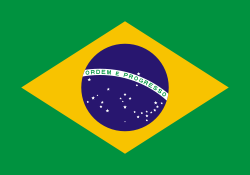 Campinas, Brazil
Campinas, Brazil Yantai, China
Yantai, China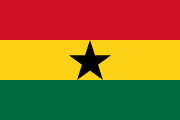 Tema, Ghana
Tema, Ghana Yokohama, Japan
Yokohama, Japan León, Mexico
León, Mexico Tijuana, Mexico
Tijuana, Mexico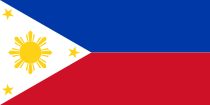 Cavite City, Philippines
Cavite City, Philippines Warsaw, Poland
Warsaw, Poland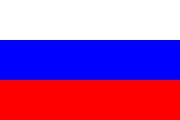 Vladivostok, Russia
Vladivostok, Russia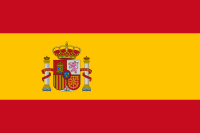 Alcalá de Henares, Spain
Alcalá de Henares, Spain Jeonju, South Korea
Jeonju, South Korea Taichung City, Taiwan
Taichung City, Taiwan
 Edinburgh, Scotland, United Kingdom
Edinburgh, Scotland, United Kingdom
Footnotes
- ↑ 1.0 1.1 "Population Estimates for the 25 Largest U.S. Cities based on July 1, 2006 Population Estimates" (PDF). US Census Bureau. Retrieved on 2007-06-28.
- ↑ "Find a County". National Association of Counties. Retrieved on 2008-01-31.
- ↑ http://ucsdnews.ucsd.edu/newsrel/awards/US_Israel.asp
- ↑ SignOnSanDiego.com > News > Politics - White House seeks limits to species act
- ↑ http://koeppen-geiger.vu-wien.ac.at/pics/kottek_et_al_2006.gif
- ↑ [1]
- ↑ C.Michael Hogan (2008) Torrey Pine: Pinus torreyana, Globaltwitcher, ed. Nicklas Stromberg [2]
- ↑ [3]
- ↑ [4]
- ↑ [5] Michael L. Wells, John F. O'Leary, Janet Franklin, Joel Michaelsen, and David E. McKinsey, "Variations in a regional fire regime related to vegetation type in San Diego County, California (USA)", Landscape Ecology, Vol. 19, No. 2, March (2004).
- ↑ [6] Bruce Evan Goldstein, "The Futility of Reason: Incommensurable Differences Between Sustainability Narratives in the Aftermath of the 2003 San Diego Cedar Fire", Journal of Environmental Policy & Planning, Vol. 9, No. 3 & 4, Sep. (2007), pp. 227 - 244.
- ↑ [7] S. Viswanathan, L. Eria, N. Diunugala, J. Johnson, C. McClean, "An Analysis of Effects of San Diego Wildfire on Ambient Air Quality", Journal of the Air & Waste Management Association, Vol. 56, no. 1, Jan (2006).
- ↑ 13.0 13.1 13.2 "American FactFinder". United States Census Bureau. Retrieved on 2008-01-31.
- ↑ San Diego Race and Hispanic Origin
- ↑ San Diego Race of total population.
- ↑ Hispanic or Latino by Type: 2000
- ↑ 17.0 17.1 "2030 Regional Growth Forecast Update" (PDF). SANDAG: Profile Warehouse (2006). Retrieved on 2007-02-18.
- ↑ "Census 2000 Profile" (PDF). SANDAG: Profile Warehouse (2006). Retrieved on 2007-02-18.
- ↑ "Places within United States:Median Household Income (In 2004 inflation-adjusted Dollars): 2004". U.S. Census Bureau: FactFinder. Retrieved on 2007-02-19.
- ↑ "SDPD Historical Crime Actuals 1950-2006" (PDF). San Diego Police Department (2006-04-14). Retrieved on 2008-03-17.
- ↑ "SDPD Historical Crime Rates Per 1,000 Population 1950-2006" (PDF). San Diego Police Department (2006-04-14). Retrieved on 2008-03-17.
- ↑ 22.0 22.1 Tony Manolatos and Kristina Davis (2006-04-14). "County crows at glowing crime report", The San Diego Union-Tribune. Retrieved on 2006-04-29.
- ↑ "Crime in the San Diego Region Mid-Year 2006 Statistics" (PDF). http://www.sandag.org/ San Diego's Regional Planning Agency] (2006-02-16). Retrieved on 2007-01-28.
- ↑ "San Diego CA Crime Statistics (2005 Crime Data)". www.AreaConnect.com. Retrieved on 2007-04-02.
- ↑ Powell, Ronald W. "Tourism district OK'd by council". San Diego Union Tribune (10-17-2007). Pg. C1/C4.
- ↑ "MilkenInstitute.org". America's Biotech and Life Science Clusters: San Diego's Position and Economic Contributions. Retrieved on 2006-12-10.
- ↑ "SD Daily Transcript". Largest employers in San Diego County. Retrieved on 2006-05-20.
- ↑ San Diego Business Journal
- ↑ Connie Lewis. "Cruise Ships Face Stiffer Anti-Pollution Policies", Proquest: San Diego Business Journal. "The Port of San Diego is the state's fastest-growing port in terms of cruise ship dockings, and the second largest behind the Port of Los Angeles... ...The dockings are estimated to have an economic impact of more than $2 million on the local economy from the purchase of food, supplies and fuel,, as well as maintenance services."
- ↑ "USS SAN DIEGO". San Diego Navy Historical Association. Retrieved on 2006-05-03.
- ↑ C.A.R. reports sales decrease 25 percent in May
- ↑ "Greener pastures outside of county?", San Diego Union Tribune (March 22,[2007]).
- ↑ [8]
- ↑ Record foreclosures in '07 - Real estate wave ebbs, leaving thousands of homeowners washed up and in debt : North County Times - Californian
- ↑ "San Diego Real Estate Slow Down Saga Continues"
- ↑ San Diego Film Commission
- ↑ "Library Fact Sheet FY 2006". San Diego Public Library. Retrieved on 2007-03-02.
- ↑ Matthew T. Hall (2006-04-12). "Budget spares libraries, parks", The San Diego Union-Tribune. Retrieved on 2007-03-01.
- ↑ "America's smartest cities". CNNmoney.com. Retrieved on 2007-03-01.
- ↑ http://www.atlasinternational.com/en-GB/usa/lifestyle/
- ↑ http://www.atlasinternational.com/en-GB/usa/lifestyle/Some
- ↑ KFMB-TV Turns 50
- ↑ "Voter Registration in the City of San Diego" (pdf). San Diego Office of the City Clerk (2007-08-01). Retrieved on 2007-08-21.
- ↑ pres_general_ssov_for_all.xls
- ↑ "San Diego Mayor Backs Same-Sex Marriage". The Guardian. 2007-11-20. Retrieved on 2007-11-20.
- ↑ [9]
- ↑ "Will Gerrymandered Districts Stem the Wave of Voter Unrest?". Campaign Legal Center Blog. Retrieved on 2008-02-10.
- ↑ Hall, Matthew (2007-05-02). "City: 37 percent of streets in acceptable driving condition", The San Diego Union-Tribune. Retrieved on 2007-05-18.
- ↑ Bicycling Magazine Recognizes Chattanooga in Top 21 Cities. Bicycling Magazine (published on Bike Chattanooga). 2006-01-26. Retrieved on 2007-08-10. (archived link)
- ↑ Downey, Dave (2006-04-24). "FAA chief says region right to consider bases", North County Times. Retrieved on 2007-02-22.
- ↑ "Creating a connection," San Diego Union-Tribune
- ↑ "Narita (NRT) Service," Aeroméxico
- ↑ "Shanghai (PVG) Service," Aeroméxico
- ↑ Craver, Joe W (2006-11-19). "A clear rejection on Miramar, so...", The San Diego Union-Tribune. Retrieved on 2007-02-22.
- ↑ "Online Directory: California, USA", Sister Cities International.
See also
- 1858 San Diego Hurricane
- List of notable San Diegans
- San Diego Harbor Police
External links
- City of San Diego Official Website
- Demographic fact sheet from Census Bureau
- History of San Diego from San Diego Historical Society
- San Diego Regional Economic Development
- San Diego Public Library
- San Diego Association of Nonprofits
- San Diego Convention and Visitors Bureau
- San Diego travel guide from Wikitravel
- San Diego is at coordinates
|
|||||||||||
|
|||||||||||||||||
|
|||||||||||
|
|
|||||||||||
|
|||||
|
|||||||||||||||||

